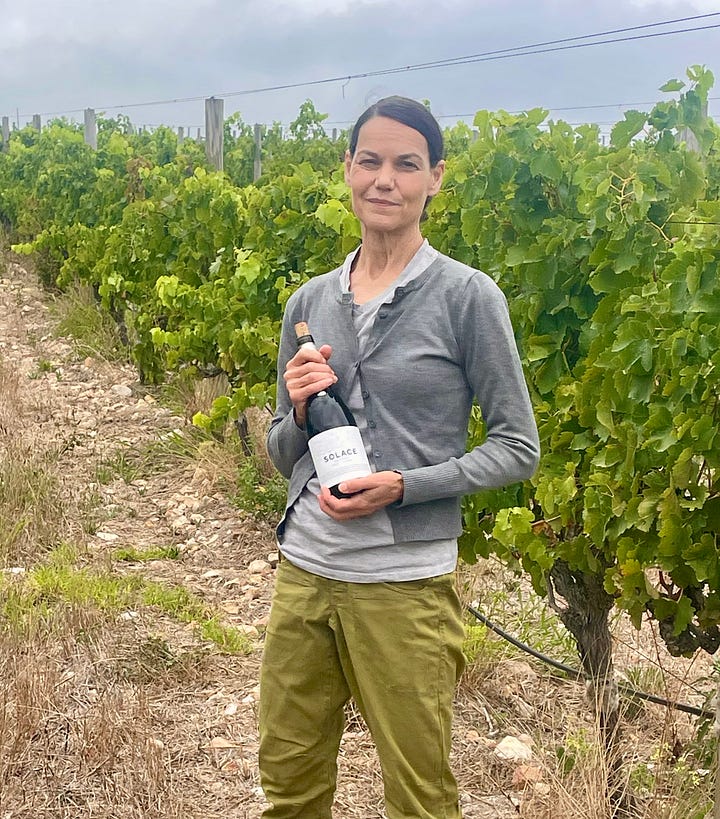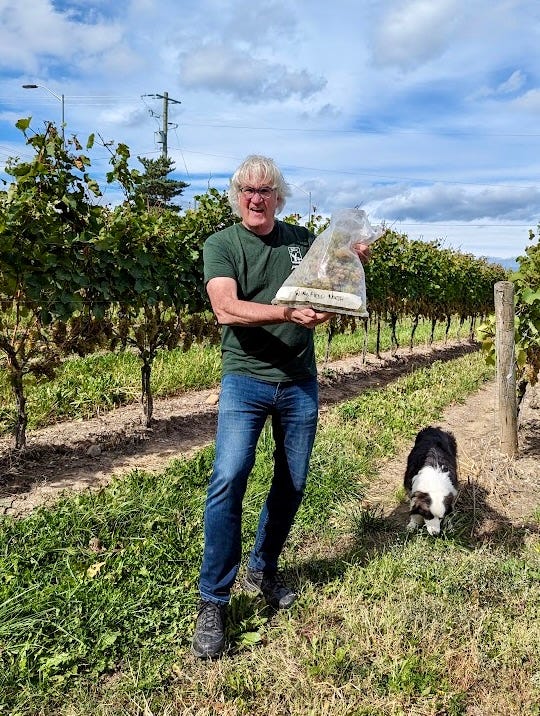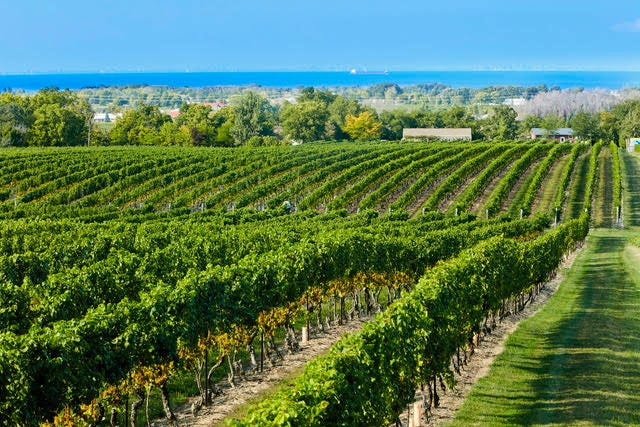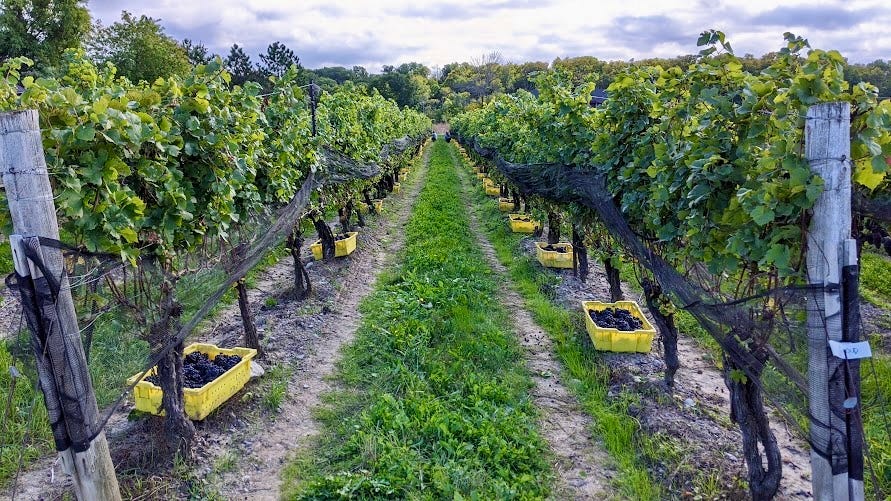Wine's new cool kids
Tastings this week from Canada and South Africa highlighted some of the New World’s best cool-climate wines. Plus: what I’ve been drinking this week.




Bumping along in Rosie Gunn’s Landcruiser, wild guinea fowl scattering from the track in front of us, I start to see why Elgin has become one of South Africa’s premier cool-climate wine regions. Despite it being high summer and broiling 60km north in Stellenbosch, here it’s overcast, breezy and cool. Her vineyards at Iona Wines sit at around 420 metres but, she says, the cooling influence of the Atlantic Ocean, just five kilometres away, is more important than altitude. When her husband Andrew first planted here, he tells me, “we concluded we had a climate between Sancerre and Burgundy.” That shows in their elegant Chardonnays and Pinot Noirs.
Flipping between hemispheres, Thomas Bachelder’s vineyards near the shores of Lake Ontario might seem in a different world. Brits tend to think of Canada as the frozen North: Bachelder is a little over 40 kilometres west of Niagara Falls and a similar distance due south across the lake from Toronto. Winters are cold, but in fact all the Ontario wine country is further south than Beaune – and more important, in this microclimate, the effect of this huge body of water is dramatic. Bachelder’s Pinot Noirs especially are elegant and precise.
I was reminded of these comparisons by two tastings on Monday this week which allowed me to compare the cool-climate wines of both countries separated only by a 10-minute walk across St James’s Park. Wines of Canada’s annual tasting at Canada House has long been one of the more agreeable national tastings, full as it is of disarmingly friendly Canadians (when I first went in 2010, they were giving away Winter Olympics mitts left over from the Vancouver Games.) Meanwhile my friend Tim Atkin MW was hosting his first “Best of South Africa” tasting amid the splendour of the Institute of Civil Engineers. Tim is one of the UK’s leading experts on South African wines, and it showed in the range of producers exhibiting.
South Africa’s Hemel-en-Aarde valley – and the nearby region of Elgin – confound the kinds of assumptions you might have about South African terroir. Elgin and Hemel-en-Aarde are closer to the equator than most of South Australia’s vineyards, or any of New Zealand’s. Yet they’re cool. The freshness of temperature here comes from the nearby Atlantic Ocean, with cool “Southeasters” blowing off it in summer. Cloud rolls in from the ocean over the mountains every day in summer, though it doesn’t reach the upper valley.
As a result, in summer, the vines get a 12-degree diurnal range – the difference between the peak daily and lowest night temperature in a 24-hour cycle. This is essential to the slow, even ripening of grapes, especially whites. (This range is also important for the large local apple crop in Elgin). Cool nights help preserve the grapes’ freshness and acidity.
In South Africa, planting in such regions makes more sense amid the increasing effects of climate change. The 2015-20 drought in the Western Cape saw some dam levels fall to as low as 14 per cent of normal, with the threat of severe water-use restrictions imminent in Cape Town, the region’s major city. Fortunately, good winter rains in 2020 averted disaster – but the long-term trend in rainfall and temperatures is disturbingly clear.
“There’s a month difference in picking times here [and in Stellenbosch],” says Alex Dale, owner of organically farmed Radford Dale, in Elgin. In Stellenbosch, he says, they never picked in January in their first 21 vintages there; since then, in the past six years they have picked every vintage in January – South-African high summer. His logic? “We future proofed the business by investing here,” he says, standing in his vineyards in Elgin.
Of course, growers can do things to moderate nature’s effects on the terroir: you can choose which way your vineyards face, or use more canopy cover or sunscreen nets against afternoon sun. But, says Craig Wessels, of Upper Hemel-en-Aarde’s Restless River, “the terroir trumps everything else. You lose its purity once you start to manipulate it.”
The land isn’t the only reason why the Canadian comparison feels odd in cool-climate South Africa. Vineyards in the Western Cape thrive in a radically biodiverse zone. It’s hard as a Brit not to do a double take the first time you drive past baboons by the side of the road here. But they are a feature of the local ecosystem – and while they prefer apples to grapes, baboons are partial to grapes too. Andrew Gunn at Iona told me there is a troop of around 20 of these large monkeys near their vineyards, which farmworkers try to ward off. Meanwhile Carolyn Martin at Creation Wines, in nearby Hemel-en-Aarde, tells me that Cape leopards, porcupines, caracals (a small lynx-like cat), fish eagles, and dassies (rock hyraxes - a large rodent) are frequent visitors to their vineyards.
In Ontario, growers evidently face different challenges. One university study last year warned of increasing rainfall and humidity in Ontario, carrying a risk of more disease pressure from funguses such as mildew. Climate change here looks more like it does in England than in South Africa. Stratus Wines’ Suzanne Janke says, “it’s a question of extremes, more than ever before,” though she also cites longer ripening in warmer autumns – which is a positive, as in southern England.
But the key environmental factor here remains Lake Ontario itself. With a surface of more than 19,000 square kilometres, the lake acts as a giant heat sink, moderating the cold of winter as well as the heat of summer on its shores. Without it, whatever the latitude here, in the middle of this huge continent these vineyards would be frozen in winter and cold even in spring. Likewise in the area’s hot, continental summers, breezes off the lake cool the vineyards in summer evenings, giving the same high diurnal range that Chardonnay and Pinot Noir grapes enjoy in Hemel-en-Aarde.
It’s not quite so simple: the region enjoys a wide range of microclimates, which has in turn led to the creation of a bewildering range of sub-appellations within the Niagara-on-the-Lake and Niagara Escarpment designations. Lake Erie North Shore and Prince Edward County are different again. But the basic principle of the “lake effect” still holds.
Can these cool-climate Chardonnays and Pinot Noirs – as well as Rieslings and Syrahs – compete with the classic expressions from Burgundy and elsewhere? I think they can. There is an elegance, complexity and finesse to many of the best wines from these cool-climate regions of Canada and South Africa that is the equal of many high-end Burgundies. Indeed I find many of these Pinot Noirs and Chardonnays from the opposite ends of the wine-growing hemispheres a lot more interesting than most village-level Burgundies at similar or even higher prices. But ultimately, of course, they’re just different – yet another expression of the vine in cooler climate.
Canada
Sadly, most Canadian wines are relatively expensive in the UK, and their distribution is patchy. But they’re worth seeking out.
Bachelder Wismer-Parke Single-Vineyard Pinot Noir 2022, Twenty-Mile Bench – this very pale Pinot is just 12.5 per cent alcohol. Very elegant and complex with a touch of earthy wildness to it: this boasts considerable finesse (VINUM and Shelved Wine have the 2020/2021, from £47.)
Cave Spring CSV Riesling 2020, Beamsville Bench – Cave Spring’s single-vineyard Riesling has the freshness and precise acidity you’d expect in this climate: complex, mineral, intense (Yorkshire Vinters, £27.)
Cloudsley Cellars Twenty Mile Bench Chardonnay 2021, Twenty Mile Bench – bright, fresh with appealing acidity and minerality; complex fruit and beautiful balance (Hedonism, £35.)
South Africa
These high end South African wines aren’t cheap but they’re impressive – and have reasonable UK availability.
Solace Syrah 2021, Elgin – this wine is from Rosie Gunn’s biodynamic vineyard, down the hill from the main Iona sites: they didn’t show it in London but I tasted it when I visited Iona in February. Bramble fruit and white pepper notes; cool, balanced and elegant in a Northern Rhône style (The Wine Society, KWM, Thorne Wines and elsewhere, from £26. Heritage Cellars and Cellar Door have earlier vintages.)
Storm “Ridge” Chardonnay 2024, Hemel-en-Aarde Ridge – made by Hannes Storm, formerly head winemaker up the road at Hamilton Russell, this is about as serious a Chardonnay as South Africa offers. Ridge is the highest bit of Hemel-en-Aarde and that is reflected is this taut wine’s precision, yet the fruit is wonderfully expressive. Lovely (the 2024 doesn’t appear to be available yet in the UK; Justerini & Brooks have the 2022, £30.17 and Lay & Wheeler have the 2023, £31.)
Paul Clüver Riesling 2024, Elgin – Clüver cellarmaster Andries Burger is best known for his Chardonnays and Pinot Noirs but I was blown away by this Riesling. Zesty fruit, precise acidity and beautiful minerality: it’s 16 grammes/litre of residual sugar but you wouldn’t know it with the acidity. Good value, too (VINUM, Frontier Fine Wines, Drink Finder, from £15.70.)
Saurwein “Om” Pinot Noir 2023, Hemel-en-Aarde – I’ve previously raved about the 2021 vintage of this gorgeous Pinot Noir from Jessica Saurwein: the 2023 that I tasted this week doesn’t appear to be on the shelves yet. Bright fruit, beautiful balance, complex and long (Handford Wines, Cellar Door Wines, Swig from £45.99.)
What I’ve been drinking this week
Juve y Camps Reserva de la Familia 2020, Cava Gran Reserva Brut – very widely available in Spain, less so here, this cava is well above average: crisp, citrussy, balanced. Perfect for a weekend lunch in the garden with friends, where I drank it (Ibero Wine, Village Wines, Taurus Wines and others have the 2018/19, from £13.42.)
Akrathos Assyrtiko 2016, Chalkidiki – Babis Bekris makes some of the best Assyrtiko that I’ve tasted outside Santorini, a brilliant take on Greece’s finest white grape. This is fresh, slightly saline, mineral, with precise acidity balancing its fruit. The 2021 is very good too but this wine improves with age. Good value for this kind of quality (All About Wine, Shelved Wine, VINUM and others have the 2020, from £23.49.)
Bodegas Habla, “Habla del Silencio” 2022, Vino de la Tierra Extremadura - an unusual blend of organic Syrah, Tempranillo and Cabernet Sauvignon grapes, grown on poor, slatey soils in this little-known wine region in the west of Spain. Herbal notes on the nose, fresh cherry fruit, mineral – different (Ultracomida, £19.95, vintage unclear; Origin Spain has the 2020, £15.50.)





My Wset diploma assignment was covering the emerging of Elgin, from an apple/pear dominant region to include viticulture. My interview with the Cluvers (as well as alex Dale and the Gunns) was an eye opener.
You’d think in America we’d have good Canadian wine distribution- I can buy one wine in my state, a dessert wine and I’m only a 4.5 hour drive from the border. Pretty sad really. As far as South Africa, we do get a few more wine from there thankfully, as they tend to never disappoint.